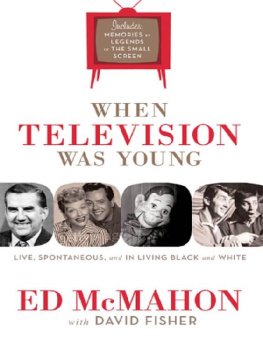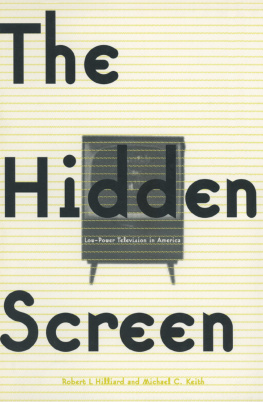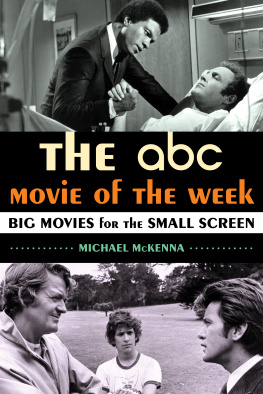Ed McMahon - When Television Was Young: The Inside Story with Memories by Legends of the Small Screen
Here you can read online Ed McMahon - When Television Was Young: The Inside Story with Memories by Legends of the Small Screen full text of the book (entire story) in english for free. Download pdf and epub, get meaning, cover and reviews about this ebook. year: 2007, publisher: Thomas Nelson, genre: Detective and thriller. Description of the work, (preface) as well as reviews are available. Best literature library LitArk.com created for fans of good reading and offers a wide selection of genres:
Romance novel
Science fiction
Adventure
Detective
Science
History
Home and family
Prose
Art
Politics
Computer
Non-fiction
Religion
Business
Children
Humor
Choose a favorite category and find really read worthwhile books. Enjoy immersion in the world of imagination, feel the emotions of the characters or learn something new for yourself, make an fascinating discovery.
- Book:When Television Was Young: The Inside Story with Memories by Legends of the Small Screen
- Author:
- Publisher:Thomas Nelson
- Genre:
- Year:2007
- Rating:5 / 5
- Favourites:Add to favourites
- Your mark:
- 100
- 1
- 2
- 3
- 4
- 5
When Television Was Young: The Inside Story with Memories by Legends of the Small Screen: summary, description and annotation
We offer to read an annotation, description, summary or preface (depends on what the author of the book "When Television Was Young: The Inside Story with Memories by Legends of the Small Screen" wrote himself). If you haven't found the necessary information about the book — write in the comments, we will try to find it.
Ed McMahon: author's other books
Who wrote When Television Was Young: The Inside Story with Memories by Legends of the Small Screen? Find out the surname, the name of the author of the book and a list of all author's works by series.
When Television Was Young: The Inside Story with Memories by Legends of the Small Screen — read online for free the complete book (whole text) full work
Below is the text of the book, divided by pages. System saving the place of the last page read, allows you to conveniently read the book "When Television Was Young: The Inside Story with Memories by Legends of the Small Screen" online for free, without having to search again every time where you left off. Put a bookmark, and you can go to the page where you finished reading at any time.
Font size:
Interval:
Bookmark:

2007 by Ed McMahon
All rights reserved. No portion of this book may be reproduced, stored in a retrieval system, or transmitted in any form or by any meanselectronic, mechanical, photocopy, recording, scanning, or otherexcept for brief quotations in critical reviews or articles, without the prior written permission of the publisher.
Published in Nashville, Tennessee, by Thomas Nelson. Thomas Nelson is a trademark of Thomas Nelson, Inc.
Thomas Nelson, Inc. titles may be purchased in bulk for educational, business, fund-raising, or sales promotional use. For information, please e-mail SpecialMarkets@thomasnelson.com.
Library of Congress Cataloging-in-Publication data
McMahon, Ed.
When television was young : the inside story with memories by legends of the small screen / Ed McMahon and David Fisher.
p. cm.
ISBN 10: 1-4016-0327-0
ISBN 13: 978-1-4016-0327-4
1. Television broadcasting--United States--History. I. Fisher, David, 1946- II. Title.
PN1992.3.U5M295 2007
384.550973--dc22
2007023836
Printed in the United States of America
07 08 09 10 11 QW 7 6 5 4 3 2 1
CONTENTS
Ive spent my life working on televisionbut making every single moment possible were those people you rarely saw, the technical crew. From the cameramen to the grips to the make-up artists, I would like to dedicate this book to all of those people who really made television possible and received so little credit. Without their hard work, great skill, and relentless dedication, we would all still be watching test patterns.
ED MCMAHON
And I would like to dedicate this to all those people who were there when this great history was being made, but especially the Stone sisters of St. Louis, Missouri; Carol Stone Maune, Joanne Stone Curtis, and Mary Stone Colombowho changed the history of my own life.
DAVID FISHER
M ANY PEOPLE GRACIOUSLY OFFERED THEIR TIME TO share their memories with me. I appreciate their contributions to this book and I hope that, together, weve captured some of the joy of the days when we invented television.
Among those many people are:
The remarkable pioneer Frances Buss, Barbara Barrie, Beverly Garland, Leslie Nielsen, Eli Wallach and Anne Jackson, Ed Reitan, the worlds expert on the history of color television (visit his wonderful website at www.novia.net), David Wolper, Jerry Lewis, Dick Clark, Stanley Hubbard Jr., Ed Blier, Ron Seggie, Ward Qualls, George Schlatter, Jerry Zeitman, Dann Cann, Stanley Rubin, Sid Cooper of the sweetest notes ever heard on NBC, Penny Marshall, Herb Schlosser, Dick Shepherd, Woody Fraser, and Mike Wallace.
I also owe a great deal to Jane Klain and Rene Reyes at the Museum of Broadcasting, for their enthusiasm and their always good-natured support. The Museum of Television and Radio, with branches both in New York and Los Angeles, is an amazing repository of television history, and well worth visiting for hours of pure entertainment as well as serious research. The most difficult thing about a visit to the museum is leaving. Or take a look at the museums website, www.mtr.org.
Also worth your time is a visit to the Academy of Television Arts & Sciences Foundations Archive of American Televisiononline at www.emmysfoundation.org/archive. Our thanks to Karen Herman, who allowed us to utilize this resource and to quote from some of the interviews. The Archive preserves the history of TV by videotaping interviews with the people who made that history, from the inventors of electronic television to the biggest stars. Its an astonishing collection including more than 500 interviews, most of them available on the websitefor free! The entire collection can be screened at the Archives offices in Hollywood. Call 818-509-2260 for information.
And naturally, I want to thank our agent, the astonishing Bill Adler and our editor, Larry Stone, who knew just when to push a little harder to get this book completed.
My collaborator, David Fisher, would also like to thank Laura Stevens for her support and her continued efforts to make this book a reality.
The elaborateness of the equipment
precludes the possibility of television
being available in homes or businesses generally.
What its practical use may be,
I leave to your imaginations.
AT&T PRESIDENT WALTER GIFFORD, APRIL 7, 1927
G REETINGS! MY NAME IS ED MCMAHON, AND I WANT TO welcome you and thank you for coming to this book. We sure have some nice-looking readers here today! I know that many of you have traveled a lot of years to get here, and I want you to know how much I appreciate it. So just settle back in your seat and relax. In just a couple of pages the book is going to start, and were going to tell you a really fascinating story. I know youre going to like it. But before I introduce Chapter 1, I want to take a few paragraphs to tell you a little about what youre going to read and get us all warmed up.
This book doesnt come with a band, but I do have some bad jokes.
Here, let me give you an example: a lot of people believe that kids today spend much too much time glued to the television set. Well, when I was growing up, believe it or not, we didnt even have television, so my parents had to glue me to the sofa.
See, thats a warm-up joke.
But there is some truth in it. I grew up before television existed. Instead we listened to a crystal set, which was a kind of homemade radio. I remember my grandfather, who lived in Lowell, Massachusetts, wrapping aerial wire around his house to try to catch the signal. Within a few years fancy radios were put inside beautiful wooden cabinets and became the central piece of furniture in a lot of living rooms, just as television sets are today. I remember I would lie on the floor in front of the radio for hours. When the wind was blowing just right, we could get as many as twenty stations. When people complained there was nothing to watch on the radio, thats exactly what they meant. We would sit and watch the radio set. Think of radio as television without the pictures.
In my house today we have eight television sets. Im not kidding. The largest one is forty-eight inches, several of them are equipped to receive high definition, and each has cable and a DVD recorder. I dont have TiVo yet because I can record anything I want to see already, and I can watch it anytime I choose to. I can get about 425 stations.
The technology is unbelievable. In my lifetime weve gone from my grandfather wrapping wire around his house to pick up a distant radio signal, to bouncing signals off satellites so that we can watch live events taking place anywhere in the world. All that incredible technology, billions of dollars, and almost a century of research all enable me to turn on any one of my eight TV sets at any time, day or night, any day of the year, and find an episode of Law & Order.
What Im going to do in this book is tell you how it all started. Television is something we all take for granted now, but it wasnt always that way. There was a time when the concept of live pictures being sent through the air was science fiction. It was fantasy, magic. How could you send pictures through the air? Close your eyes and just think about that. Think about the wonder of the magic we take for granted. Pictures being sent through the air!
And once the magicians made it possible, the question became, what pictures would be shown on this magic box? Once the amazement had worn off, what pictures would capture the imagination? Would it be expensive? Who would pay for it? There were no answers to any of these questions. It all had to be imagined and created and discovered. The story Im going to tell is how it all happened. I know the story because I lived through it.
Next pageFont size:
Interval:
Bookmark:
Similar books «When Television Was Young: The Inside Story with Memories by Legends of the Small Screen»
Look at similar books to When Television Was Young: The Inside Story with Memories by Legends of the Small Screen. We have selected literature similar in name and meaning in the hope of providing readers with more options to find new, interesting, not yet read works.
Discussion, reviews of the book When Television Was Young: The Inside Story with Memories by Legends of the Small Screen and just readers' own opinions. Leave your comments, write what you think about the work, its meaning or the main characters. Specify what exactly you liked and what you didn't like, and why you think so.













